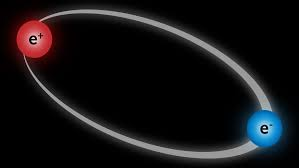The fact is that energy alone cannot make that thing. In my previous text, I introduced the model where a quantum tornado surrounds the superstring. And in that model, the string inside the tornado pulls objects away. Or superstring delivers energy to the particle. That will send it away as wave movement.
The quantum tornado forms electromagnetic low-pressure in it. The low-pressure is forming when that tornado sends wave movement to the string. And that wave movement forms the small quantum low-pressure that pulls energy out from particles. That low pressure also pulls particles to it.
Above) Positronium (electron and positron). Particle-pair is where two particles orbit each other. That kind of structure can make electromagnetic (quantum) overpressure and low-pressure that alternate each other. That makes particles push and pull at the same time.
Are hypothetical WIMP particles particle pairs? That explains why nobody sees them.
The question is this: is the hypothetical WIMP particle(Weakly Interacting Particle) a particle-pair that sends extremely thin electromagnetic wave movement pikes around it? When that (probably) superpositioned particle-pair orbits each other.
That thing acts like a quantum propeller that harvests energy from around it. And then it conducts energy from electromagnetic fields around them? So are those hypothetical WIMPs superpositioned and entangled Higgs bosons or neutrinos?
If WIMP is the particle pair. That explains why we cannot see it. And if WIMP is particle pair that rotates each other and then acts as an energy harvester, it can explain dark energy. Dark energy is that energy that source is mysterious WIMP.
But otherwise thinking of the particle pair that orbits each other can make the effect that pushes and pulls objects. The idea is when those particles are orbiting each other. They send thin pike-looking waves away from them. The particle-pair acts like an antenna that sends electromagnetic radiation around it. That thing forms electromagnetic low-pressure between those radiation pikes. And that low pressure pulls particle to particle pair.
When they are towards some other particle, they send very thin electromagnetic radiation pike to that particle. And when they are turning away. That particle where radiation pike hits sends extra energy away from it as the form of wave movement. That thing makes it possible. That the same particle can push and pull other particles at the same time.
https://www.sciencenews.org/article/positronium-energy-levels-exotic-atom-physics
https://en.wikipedia.org/wiki/Positronium
https://en.wikipedia.org/wiki/Weakly_interacting_massive_particle
https://webelieveinabrightfuture.blogspot.com/


Comments
Post a Comment